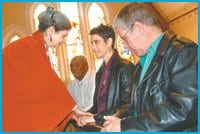
HOLY BROTHERS. A leather-inspired reimagining of St Crispin and his companion St Crispinian Credit: AJAY THAPA
A Toronto church is giving new meaning to two little-known Christian martyrs. According to legend St Crispin and his companion St Crispinian were leatherworkers in the third century who evangelized Gaul (what is today western Europe). They’ve long been seen as the patron saints of leatherworkers and shoemakers but the parish of St Peter’s Anglican Church has now claimed them as the patron saints of leatherfolk.
“[St Crispin and St Crispinian] were leatherworkers who were martyred in 285 AD in Rome, which is why in the Christian Church we remember them,” says Judy Herron-Graham, the priest at St Peter’s. “They died because they would not renounce their Christian faith. They’ve been remembered for over 1,700 years.
“Not a lot is known of the details of their lives or deaths,” adds Herron-Graham, who has been preaching at the gaybourhood-area church for nine years. “We only know they were martyred and have become the patron saint of leatherworkers so we have extrapolated that and they have become the patron saints of leather people.”
St Peter’s recently marked the feast day of saints Crispin and Crispinian — traditionally Oct 25, said to be the day of their deaths — with a special Sunday leather service held on Oct 28. Celebrating the pair of saints with a leather service is a way of reaching out to a subculture that may not feel welcome in many church settings.
“There are several segments of our society for whom leather is an important part of their lifestyle, such as bikers and leather groups,” says Herron-Graham.
“We’re hoping that this will be the first of many and we hope this will become a church of the leather community with which the leather community identifies,” she adds.
A service that reaches out to leatherfolk is in keeping with St Peter’s goal to welcome all sorts to the church says guest preacher Harold Jenkins, who conducted the Oct 28 leather service.
“We have people from all strata of society in terms of income and national origin, gay and straight and whatever you like,” says Jenkins, who was an Anglican preacher for seven years. “We are a very inclusive bunch. We have men who wear women’s clothing who come to church like that. Any variety that exists in Toronto can be found at St Peter’s.”
So what does it mean to have a patron saint? “Traditionally a patron saint is regarded as an example of life and courage for a particular group of people,” says Jenkins.
Jenkins’ partner Ernie Wesley, a Catholic and member of the leather club Spearhead, says that many Christians choose a patron saint that represents their way of life and then pray to them for guidance.
“There is a saint of whatever you’re involved with, for sailors, for leather,” says Wesley. “St Peter is for fishermen. There are hundreds. We [Catholics] have a patron saint when we’re confirmed. We all have our own patron saint.”
Although the Catholic Church still considers St Crispin and St Crispinian to be saints, the pair was removed from the Catholic liturgical calendar in the 1960s in part due to suspicion that the men hadn’t actually existed and that they represented the preexisting local Celtic deity Lugus-Mercurius.
According one version of the story Crispin and Crispinian (sometimes described as brothers or even twins) were born in Rome but fled religious persecution. They wound up in Soissons, in what is now France, where they set up shop as leatherworkers, preaching by day and making shoes by night. They promoted charity, piety and contempt for material wealth.
The pair came to the attention of coemperor Maximianus Herculius who sent them to be interrogated by governor Rictiovarus.
“Under the order of Rictiovarus they were stretched on the rack, thongs were cut from their flesh and awls were driven under their fingernails,” states the 1908 version of the Catholic Encyclopedia. “A millstone was then fastened about the neck of each and they were thrown into the Aisne, but they were able to swim to the opposite bank of the river. In the same manner they suffered no harm from a great fire in which Rictiovarus, in despair, sought death himself.”
The pair was ultimately beheaded at the order of the coemperor on Oct 25, 285 AD.


 Why you can trust Xtra
Why you can trust Xtra


